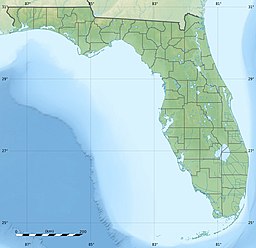geo.wikisort.org - Sea
Choctawhatchee Bay is a bay in the Emerald Coast region of the Florida Panhandle. The bay, located within Okaloosa and Walton counties, has a surface area of 334 square kilometres (129 sq mi).[2] It is an inlet of the Gulf of Mexico, connected to it through East Pass (also known as Destin Pass). It also connects to Santa Rosa Sound in Fort Walton Beach, Florida to the west and to St. Andrews Bay in Bay County to the east, via the Gulf Intracoastal Waterway. East Pass is the only outlet of the bay flowing directly into the Gulf of Mexico.[3] The Choctawhatchee River flows into Choctawhatchee Bay, as do several smaller rivers and streams.[2][4] The Mid-Bay Bridge crosses the bay, connecting the city of Destin to Niceville, Florida.

| Choctawhatchee Bay | |
|---|---|
 Satellite image of the Choctawhatchee Bay | |
| Coordinates | 30°26′22″N 86°18′40″W |
| Primary inflows | Choctawhatchee River |
| Primary outflows | Gulf of Mexico, Santa Rosa Sound |
| Catchment area | 5,405 square miles (14,000 km2) |
| Max. length | 27 miles (43 km)[1] |
| Max. width | 6 miles (9.7 km) |
| Surface area | 129 square miles (330 km2) |
| Max. depth | 43 feet (13 m) |
| Settlements | Fort Walton Beach, Destin Santa Rosa Beach, Freeport, Niceville, Shalimar, Valparaiso |
History

This section needs expansion. You can help by adding to it. (June 2008) |
The bay was charted by Spanish, French, and English expeditions, The bay appears on some charts as "St. Rose's Bay".[5][6]
Military Use
As noted in a 1993 Eglin AFB report, Test Area D-55 was originally installed in the World War II era by Eglin Air Force Base with "omnidirectional radar corner reflectors" on top to be used as a radar target range.[7]
Test Area D-55 is formed by 25 arrays of 2,040 wood pilings placed east of the Clyde B. Wells Bridge. They are located in 8 feet of water and the array extends for 1.2 miles.
Municipalities
Several towns and cities are located around the Choctawhatchee Bay:
- Fort Walton Beach
- Destin
- Santa Rosa Beach
- Freeport
- Niceville
- Shalimar
- Valparaiso
Tributaries
Below are a few of the tributary rivers and bayous that feed into the Choctawhatchee Bay.
Rivers
- Choctawhatchee River
- Mitchell River
- Black Creek
Bayous
- LaGrange Bayou
- Alaqua Bayou
- Basin Bayou
- Rocky Bayou
- Boggy Bayou
- Cinco Bayou
Lakes
- Pippin Lake
- Jack Lake
- Lower Memorial Lake
- Bens Lake
- Lake Lorraine
- Lake Vivian
- Lake Clyde
- Lake Earl
References
- Ruth, Barbara; Handley, Lawrence R. (2006). "Choctawhatchee Bay" (PDF). U.S. Geological Survey. Retrieved 2 August 2020.
- "GulfBase - Choctawhatchee Bay". Archived from the original on 2007-11-30. Retrieved 2007-11-25.
- "EAST PASS INLET MANAGEMENT STUDY IMPLEMENTATION PLAN CERTIFICATE OF ADOPTION" (PDF). Florida Department of Environmental Protection. Archived from the original (PDF) on 2006-03-08. Retrieved 2007-11-26.
- "Choctawhatchee Info - HISTORICAL". Retrieved 2007-11-25.
- John D. Ware (1982). George Gauld, Surveyor and Cartographer of the Gulf Coast. Gainesville: University Press of Florida.
- "The Coast of West Florida and Louisiana. Jefferys, Thomas, 1775". The David Rumsey Collection. Retrieved 2007-11-26.
- 30A (2020-05-01). "What are those mysterious pilings in Choctawhatchee Bay by the 331 bridge?". 30A. Retrieved 2020-08-31.
Другой контент может иметь иную лицензию. Перед использованием материалов сайта WikiSort.org внимательно изучите правила лицензирования конкретных элементов наполнения сайта.
WikiSort.org - проект по пересортировке и дополнению контента Википедии
